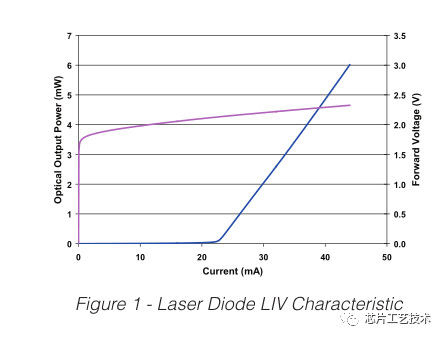Lifetime Reliability of Laser Chips
The reliability of the laser chip is a very key indicator. Whether it is a low-power laser pointer or a laser communication chip with high requirements, it is necessary to test the aging and reliability of the chip.
Compared with traditional electronic chips, laser testing is more complicated, involving optical and electrical measurements, and the difference in packaging forms must also be considered. The burn-in test is used as a detection method for the chip. In the early stage of research and development, a lot of chip quality information can be obtained through the chip burn-in test, and some early process problems can be found.
We know that the measurement of laser chips generally depends on LIV data, as shown in the figure below:

The photoelectric parameters of the laser are greatly affected by heat.

As shown in the figure above, as the temperature increases, the threshold current of the chip increases.

Usually, after the wafer is completed, it needs to be inspected at the wafer level first. At this time, because the light emission on the side cannot be tested, it is generally not checked by power-on, and the appearance and the critical dimensions of some chips are checked.
After the second step is split into bars, you can initially test the light output situation, because there is no specific light output surface and reflective surface, so it is not a completely correct laser mode, and the luminous power can simply be considered to be the same at both ends.
The third step is to coat the AR surface and the HR surface, and then perform the Bar test. After the test, it can be divided into individual chip particles.
For aging, it can only be carried out after the chip packaging is completed, such as To9 packaging.
The lifetime of the chip can use the Arrhenius formula: Arrhenius equation (Arrhenius equation) is a chemical term, which is an empirical formula for the relationship between the chemical reaction rate constant and the temperature change created by Arrhenius of Sweden.
Transferring to the laser chip is:

As shown in the figure above, the laser with Ea=0.7eV has a lifetime of 100,000 hours at room temperature of 20°C, but only 2,300 hours at 70°C.
The packaged chip life test generally needs to be aged for 1000 hours, or even longer. In the communication industry, there is a Telcordia test standard for laser testing.
Accelerated aging is a means of rapid testing, through high temperature, large injection current, or higher output power. High temperature is a commonly used direction.
Three commonly used test modes for burn-in:
1) Constant current mode mode, during the aging process, it provides an ACC (automatic current control) mode, that is, constant current.
2) Constant power mode, also called APC (automatic power control), the optical power of the outgoing light is kept at a constant (by adjusting the current supply). The power mode is more commonly used in burn-in tests because it is closer to the actual application scenario.
3) Periodic testing. Put the laser into a 100°C environment and take it out regularly to measure it.
In the actual aging project of lasers, if periodic testing is adopted, there will also be many external factors, mainly temperature instability, equipment measurement and control instability, equipment reliability and power failure. One reason for the difficulty in temperature control is the self-heating of the laser. Even if the To-can package on the exposed aluminum heat sink is tightly inserted, the laser also has a thermal resistance of 5-10C/W. If the laser operates at 100mA and 1.8V, there may be a temperature difference of 1.5°C between the laser and the heat sink.
In addition, the laser is very sensitive to temperature at a given current, even if the heat sink only fluctuates by 0.1°C, it will cause noise in the output optical power. Moreover, the external photodiode used for measurement will also be affected by temperature, and then different optical power data will be obtained, so its temperature also needs to be controlled.
Laser life cycle studies require accurate measurements of even a few percent changes in laser operating parameters over thousands of hours. Therefore, the stability of the test equipment must reach 0.1% within 1000 hours.
The picture above is the test result of 16 DFB lasers in APC mode at 75°C for 1000 hours.
Usually the aging speed is the fastest in the first few hundred hours of the test, and then there is a stable linear aging characteristic, and the service life of each laser is a straight line in the linear region. So the service life at a predefined current can be deduced.
For example, a 20% change in current is used as the end of service life. Lifetime estimates range from 360 hours to 16,450 hours at 75°C, and these data are distributed through a Weibull probability yielding an average lifespan of 2,200 hours.
In the picture above, there is a straight drop at 930 hours, which is caused by a sudden power failure of the aging system. After the subsequent power-on, the graph can continue to go, indicating that the aging can be interrupted, but try not to plug it in. Laser2 is at 500-800 hours. Unstable readings can be observed. This is also a common phenomenon in aging tests. It has something to do with the test hardware and methods. Don’t pay too much attention to it. It may jump when it vibrates next to it.
Lifetime Reliability of Laser Chips
Aging is an important process of laser product selection, to screen out those products that may have a short life, so that the remaining large number of lasers have satisfactory and acceptable reliability. Because aging has an impact on production cost and time, the general aging time is less than 100 hours.

